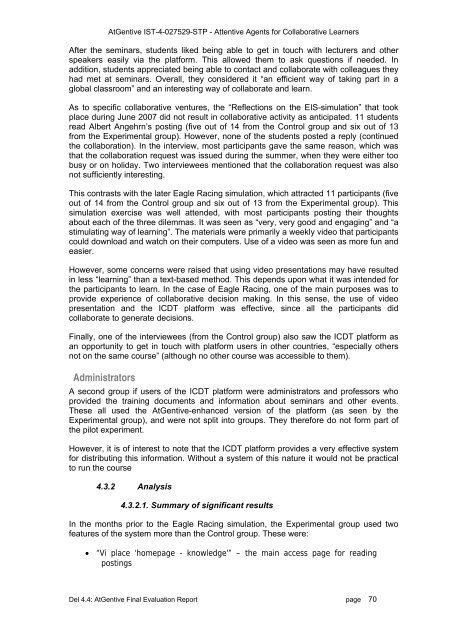Deliverable 4.4 - INSEAD CALT
Deliverable 4.4 - INSEAD CALT
Deliverable 4.4 - INSEAD CALT
Create successful ePaper yourself
Turn your PDF publications into a flip-book with our unique Google optimized e-Paper software.
AtGentive IST-4-027529-STP - Attentive Agents for Collaborative LearnersAfter the seminars, students liked being able to get in touch with lecturers and otherspeakers easily via the platform. This allowed them to ask questions if needed. Inaddition, students appreciated being able to contact and collaborate with colleagues theyhad met at seminars. Overall, they considered it “an efficient way of taking part in aglobal classroom” and an interesting way of collaborate and learn.As to specific collaborative ventures, the “Reflections on the EIS-simulation” that tookplace during June 2007 did not result in collaborative activity as anticipated. 11 studentsread Albert Angehrn’s posting (five out of 14 from the Control group and six out of 13from the Experimental group). However, none of the students posted a reply (continuedthe collaboration). In the interview, most participants gave the same reason, which wasthat the collaboration request was issued during the summer, when they were either toobusy or on holiday. Two interviewees mentioned that the collaboration request was alsonot sufficiently interesting.This contrasts with the later Eagle Racing simulation, which attracted 11 participants (fiveout of 14 from the Control group and six out of 13 from the Experimental group). Thissimulation exercise was well attended, with most participants posting their thoughtsabout each of the three dilemmas. It was seen as “very, very good and engaging” and “astimulating way of learning”. The materials were primarily a weekly video that participantscould download and watch on their computers. Use of a video was seen as more fun andeasier.However, some concerns were raised that using video presentations may have resultedin less “learning” than a text-based method. This depends upon what it was intended forthe participants to learn. In the case of Eagle Racing, one of the main purposes was toprovide experience of collaborative decision making. In this sense, the use of videopresentation and the ICDT platform was effective, since all the participants didcollaborate to generate decisions.Finally, one of the interviewees (from the Control group) also saw the ICDT platform asan opportunity to get in touch with platform users in other countries, “especially othersnot on the same course” (although no other course was accessible to them).AdministratorsA second group if users of the ICDT platform were administrators and professors whoprovided the training documents and information about seminars and other events.These all used the AtGentive-enhanced version of the platform (as seen by theExperimental group), and were not split into groups. They therefore do not form part ofthe pilot experiment.However, it is of interest to note that the ICDT platform provides a very effective systemfor distributing this information. Without a system of this nature it would not be practicalto run the course4.3.2 Analysis4.3.2.1. Summary of significant resultsIn the months prior to the Eagle Racing simulation, the Experimental group used twofeatures of the system more than the Control group. These were:• “Vi place 'homepage - knowledge'” – the main access page for readingpostingsDel <strong>4.4</strong>: AtGentive Final Evaluation Report page 70
















